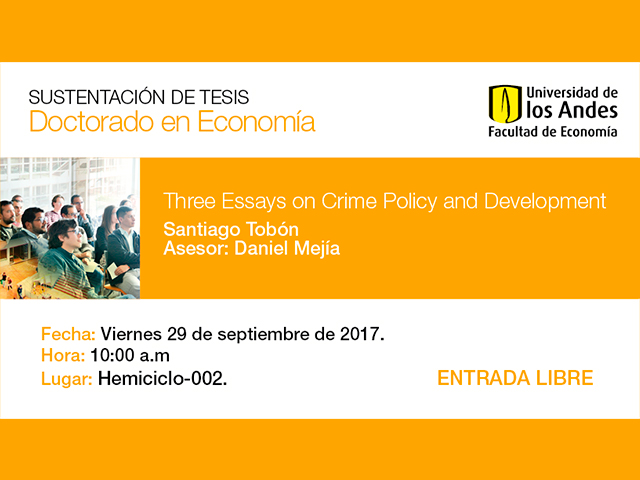Sustentación Tesis Doctorado

Abstract
Successful crime control policies are key for economies transitioning towards development. The three chapters in this dissertation aim to evaluate the effects of law enforcement policies as well as characteristics of the prison system on violence, criminal behavior and state legitimacy.
In the first chapter I use the allocation of inmates to old and new Colombian prisons to examine the effects of poor prison conditions on recidivism. Old prisons in Colombia characterize by widespread overcrowding, deficient electric and plumbing networks, lack of maintenance, insufficient personnel for security and management, and under supply of rehabilitation programs. New prisons, on the other hand, meet most technical requirements to provide security and services to all inmates. I find that inmates allocated to new prisons recidivate about one-third less relative to other inmates. Moreover, I also find weak evidence on larger effects for inmates convicted for property crimes or higher educational levels when arrested. Taken together, these results suggest that individuals released from new prisons may have a higher level of human capital which, on the margin, takes them out of criminal activities.
In the second chapter (with Christopher Blattman, Donald Green and Daniel Ortega) we evaluate the effects of hot spots policing and municipal services on crime, violence and state legitimacy. We identified 1,919 high-crime street segments in Bogotá, Colombia and randomized them to eight months of increased police patrol time, clean-up and lighting services, both, or neither. We show how to design place-based experiments to test for spatial spillovers over varying distances, and estimate direct and spillover effects using randomization inference. We find that increasing state presence reduces insecurity on targeted streets. There may be increasing returns to state presence and to targeting the least secure places. But data from all 137,000 city streets suggest that targeted state presence may simply push insecurity around the corner, and that there is no decrease in total crime in the city. This varies by type of crime: property crime appears to displace, while there is weak evidence violent crimes decrease. In the eyes of the public, greater state presence increases neither trust in the state nor its perceived legitimacy.
In the third chapter (with Santiago Gómez and Daniel Mejía) we benefit from a quasi-experimental setting in Medellín, Colombia to evaluate the deterrent effects of public surveillance cameras on criminal behavior. We find a decline in both crime reports and arrests after the installation of the cameras. Since the monitoring capacity of the cameras deteriorated during the installation period, and the usage of camera footage is unlikely to affect the likelihood of a conviction for offenders arrested within the coverage zone of the cameras in the time frame of this evaluation, these results suggest that the effects of the surveillance cameras on reported crimes could be driven mainly by a deterrent effect on potential offenders. We also find no evidence of close range negative or positive spillovers after the installation of the cameras.

